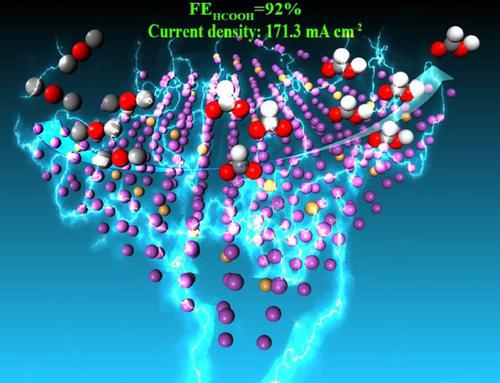Science China Materials ( IF 6.8 ) Pub Date : 2023-03-24 , DOI: 10.1007/s40843-022-2373-5 Yanjie Hu , Xinying Wang , Jiacheng Zhang , Jiaming Zhang , Yangtao Zhang , Jiawen Liang , Yunyong Li

|
The electrocatalytic carbon dioxide reduction reaction (CO2RR) to obtain valuable formic acid (HCOOH) with high Faradaic efficiency (>90%) and large current density (>150 mA cm−2) in H-type cells is extremely challenging due to the carbon dioxide (CO2) mass transfer limitation. This study reports an excellent electrocatalyst for the CO2RR based on the in-situ construction of three-dimensional (3D) porous networked core-shell nanowire structures on copper (Cu) foam. The core-shell structure comprises a Cu nanowire (NW) core and an antimony-bismuth (Sb-Bi) alloy shell (Cu@SbxBiy NWs/Cu). The as-prepared Cu@SbxBiy NWs/Cu exhibits a high current density of 171.3 mA cm−2 along with 92% Faradaic efficiency of HCOOH (FEHCOOH), which is superior to most reported studies in terms of high current density. Theoretical research has shown that introducing Sb upshifts the electron states of Bi close to the Fermi level, allowing more advantageous adsorption of the ⋆OCHO intermediate onto Sb-Bi interfaces than Bi surfaces, thereby accelerating the CO2RR. Furthermore, Sb0.1Bi1 has stronger bond energy than pure Bi, favoring the stability of the catalyst during the reaction. Additionally, the formation of the Sb0.1Bi1 alloy and 3D conductive core-shell nano-networks is more conducive to fast electron transfer and exposure of more active sites in the reaction process, obtaining better catalytic activity. This study provides valuable insights into the design of highly active Bi-based catalysts for energy conversion.
中文翻译:

用于高效电催化 CO2 还原的铋合金纳米片的原位工程 3D 导电核壳纳米网络和电子结构
在 H 型电池中以高法拉第效率 (>90%) 和大电流密度 (>150 mA cm -2 )获得有价值的甲酸 (HCOOH) 的电催化二氧化碳还原反应 (CO 2 RR) 极具挑战性,因为二氧化碳 (CO 2 ) 传质限制。本研究报告了一种基于在铜 (Cu) 泡沫上原位构建三维 (3D) 多孔网络核壳纳米线结构的CO 2 RR 的优异电催化剂。核-壳结构包括铜纳米线 (NW) 核和锑-铋 (Sb-Bi) 合金壳 (Cu@Sb x Bi y NWs/Cu)。所制备的 Cu@Sb x Bi yNWs/Cu 表现出 171.3 mA cm -2的高电流密度以及 HCOOH (FE HCOOH ) 的 92% 法拉第效率,这在高电流密度方面优于大多数报道的研究。理论研究表明,引入 Sb 会使 Bi 的电子态上移接近费米能级,从而使⋆ OCHO 中间体比 Bi 表面更有利地吸附到 Sb-Bi 界面上,从而加速 CO 2 RR。此外,Sb 0.1 Bi 1具有比纯Bi更强的键能,有利于催化剂在反应过程中的稳定性。此外,Sb 0.1 Bi 1的形成合金和3D导电核壳纳米网络更有利于反应过程中电子的快速转移和更多活性位点的暴露,获得更好的催化活性。这项研究为设计用于能量转换的高活性铋基催化剂提供了宝贵的见解。






























 京公网安备 11010802027423号
京公网安备 11010802027423号